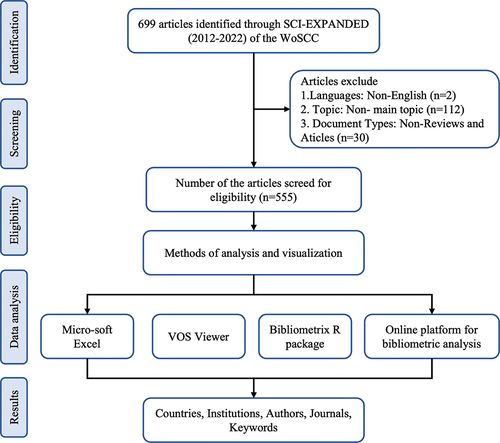ABSTRACT
Immunotherapy has revolutionized cancer treatment. B7-H3 is a promising target for cancer immunotherapy (CI). The present study aimed to utilize bibliometric methods to assess the current research status and explore future trends in the use of B7-H3 for CI. We collected publications related to B7-H3/CI from the Clarivate Web of Science Core Collection database. VOSviewer, Microsoft Excel, the bibliometrix R package, and an online platform were used to conduct qualitative and visualized analyses of the literature. A total of 555 papers were analyzed, revealing a significant increase in annual publications since 2018. The most productive countries were China and the USA, and the leading institutions were Soochow University and Sichuan University. Zang and Ferrone were the most popular authors. Among the journals, Frontiers in Immunology had the highest number of papers, whereas Clinical Cancer Research was the most influential. Historical citation analysis reveals the development of B7-H3/CI. Top-cited papers and keyword analyses were performed to highlight current hotspots in the domain. Using cluster analysis, we classified all keywords into four clusters: “immunotherapy,” “co-stimulatory molecule,” “B7 family,” and “PD-L1.” Finally, Trends analysis suggested that future research might focus on “chimeric antigen receptor,” “pathways,” and “targeting B7-H3.” This is the first bibliometric crosstalk analysis between B7-H3 and CI. Our study illustrates that the topic of B7-H3/CI is very popular and has great clinical implications and that the number of correlative publications will continue to increase. B7-H3-based CI may lead to new research trends.
Introduction
In the past decade, immune checkpoint inhibitors (ICIs), primarily targeting Programmed Death 1 (PD1), Programmed Death-Ligand 1 (PD-L1), and Cytotoxic T-lymphocyte-associated protein 4 (CTLA-4), have made significant strides in the treatment of various solid tumors, remodeling therapeutic practice in oncology.Citation1–4 Although ICIs show robust antitumor effects, their efficacy is limited by the heterogeneity of tumors, drug resistance, and adverse events.Citation5–7 Therefore, identifying other potential targets for cancer immunotherapy (CI) is critical.
CI depends on immune escape mechanisms, and the specific correction of immune deficiency to restore natural antitumor immunity and immune normalization is essential for the efficacy of CI.Citation8 The B7 family is involved in the immune response by regulating the activation, proliferation, differentiation, and function of immune cells.Citation9 Similar to the well-studied B7-H1(PD-L1), the B7 homolog 3 protein (B7-H3) is a member of the B7 family. B7-H3 is an immune checkpoint molecule functions as a co-stimulatory/co-inhibitory molecule and plays a contradictory role in the human immune system.Citation10 It has received much attention in the past decade since the first identification in 2001.Citation11 The B7-H3 gene is located on chromosome 15,Citation12 and the B7-H3 protein is produced in both transmembrane or soluble isoforms.Citation13 Transmembrane B7-H3 has 316 amino acids with a molecular weight of 45–66 kDa,Citation14 which consists of an extracellular domain, a transmembrane domain, and a short intracellular domain.Citation15 Soluble B7 - H3 (sB7-H3) has been detected in human serum and is produced by cleavage from the surface by matrix metalloproteinases (MMPs)Citation16 or alternative splicing of introns.Citation17
Accumulating evidence has demonstrated that B7-H3 weakens T-cell activation and increases regulatory T-cell infiltration, decreasing the efficacy of immunotherapy.Citation18,Citation19 Moreover, B7-H3-mediated tumor glycolysis increases resistance to CI.Citation20,Citation21 Several preclinical and clinical studies have demonstrated the feasibility of anti-B7-H3 therapy.Citation22 Moreover, high levels of B7-H3 augment angiogenesis and reconstruct the extracellular matrix to promote metastasis, contributing to poor prognosis of patients.Citation23–25 Thus, B7-H3 has been identified as a valuable biomarker for patient prognosis and a potential target for CI.Citation26,Citation27 Despite the growing attention that B7-H3 has received, there is a lack of systematic quantitative analysis of the output, current hotspots, and future study trends in B7-H3/CI on a global scale.
Bibliometric analysis employs statistical and mathematical methods to study literature’s quantity, quality, citations, and impact in a specific field.Citation28 Its objective is to reveal the scientific research capabilities of researchers, institutions, and countries based on quantitative support and to investigate research trends and hotspots by evaluating the metrological characteristics of papers.Citation29 In this study, we applied bibliometric analysis to outline the current status of B7-H3/CI and identified new directions for researchers in this field.
Materials and methods
Data source and search strategy
All publications on B7-H3/CI were retrieved from the Science Citation Index Expanded (SCIE) from the Web of Science Core Database (WOSCC) on November 20, 2022. The search strategies were TS = “B7-H3” and “immunotherapy” and “cancer.” The synonyms of the search terms and the wildcard “*” were used to expand the search scope and ensure the comprehensiveness of the search. The complete search terms are shown in “Supplementary Material S1”. The publications’ investigations ranged from 2012 to 2022. Document types were confined to “review” and “article.” After excluding non-English and non-main-topic literature, 555 records were downloaded as text files from the WOS ().
Data analysis and visualization
The Bibliometrix R package (version 4.2.1) was used to visualize the analysis of journals, countries/affiliations, and authors. The production dynamics, impact of journals, and history of direct citations were revealed using VOSviewer (version 1.6.18), facilitating the construction of a keyword co-occurrence analysis (frequency >10) and the citation network of institutions. An online platform (http://bibliometric.com) displays the cooperation networks between researchers and countries.
Results
The trend of global publications and citations
The number of publications (Np) increased from 2012 to 2022, with a notable spike from 2018 to 2022 (). Microsoft Excel 2019 was used to build a polynomial regression model to predict the Np in 2023. The model’s formula and R2 were y = 0.7646 × 2–0.5566 x +18.352 and 0.9214, respectively, which indicated a reliable predictive performance. Based on the fitted curve, we estimated that Np for the entire year 2022 could be approximately 105, and it may increase to approximately 120 in 2023.
Figure 2. (a) annual output and polynomial fitting curve of publications in B7-H3/CI. (b) the yearly average number of citations in B7-H3/CI.
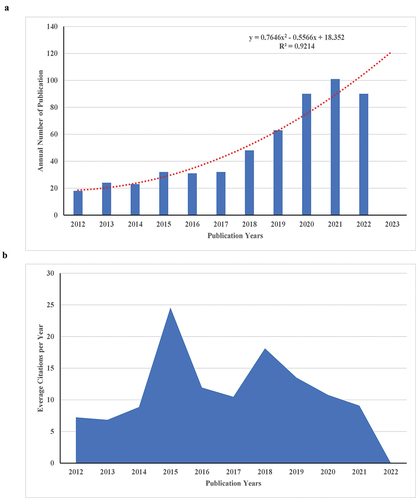
Papers published in 2015 and 2018 had a crucial scholarly impact, with average citations peaking at approximately 25 and 18, respectively, in two years (). As presented in , the top five articles in terms of total citations (TC) were TOPALIAN (2015), WEI (2018), MAHONEY (2015), GREEN (2012), and CHAUVIN (2015). Higher quality and lower NP contributed to the highest average annual citations in 2015. However, since 2018, the average number of citations has decreased, possibly due to the deferred citations in recent studies.
Table 1. The top 10 global cited papers related to B7-H3/CI based on total citations.
Analysis of journals
All the papers, including 401 articles and 144 reviews, were published in 233 journals. shows that the most productive journal was Frontiers in Immunology (n = 29), followed by Frontiers in Oncology (n = 23). The impact of journals was measured using TC and H-index indicators. Cancer Cell had the highest TC, with 2639 citations (), while Clinical Cancer Research was the most influential journal, according to the H-index (). shows that the top 10 journals cumulatively published 167 papers, accounting for approximately 30.09% of the total publications. The dynamics of the cumulative NP in the top 10 journals are shown in .
Figure 3. (a) the top 10 influential journals measured by TC. (b) the top 10 influential journals measured by H-index. (c) the top 10 productive journals. (d) the dynamics of the cumulative number of papers of the top 10 journals in B7-H3/CI.
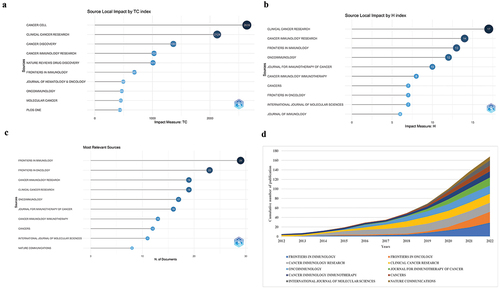
Table 2. The top 10 productive journals related to B7-H3/CI.
Analysis of authors
The dataset involved 3743 authors, with the top 10 prolific authors coming from China and the USA, especially from Sichuan University West China Hosp. Zang XX showed apparent advantages in terms of NP, H-index, and TC, indicating a significant influence on B7-H3/CI (). Additionally, Zang began publishing relevant research as early as 2012, whereas half of the authors did not do so until 2017, with most papers published in 2019 (). In terms of author collaboration, Tong AP, Zhou LX, and Guo G had the strongest links ().
Figure 4. (a) the top 10 authors’ production over time in B7-H3/CI. (b) the top 20 authors’ cooperative network (each node corresponds to an author, the node’s size corresponds to the NP of the author, the line between authors represents a collaborative relationship, and the thickness of the line corresponds to the intensity of cooperation). (c) the trends in NP of top 5 productive institutions over time. (d) the citation network of 50 institutions.
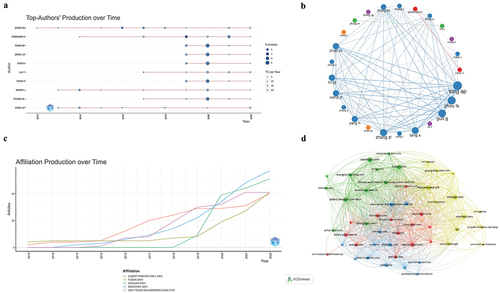
Table 3. The top 10 productive authors related to B7-H3/CI.
Analysis of countries/regions and institutions
We analyzed 818 institutions in this study. lists the top 10 institutions in Np, six of which are from China. The top five institutions were Soochow University, Sichuan University, Fudan University, the University of Texas MD, Anderson Canc Ctr, and the Albert Einstein Coll Med. shows the trends in Np of the top five institutions. Among these, Soochow University ranked first in NP, while Sichuan University was the latest to start but the fastest to develop. The citation links between the 50 institutions publishing no fewer than five papers formed the citation network shown in .
Table 4. The top 10 productive countries/regions and institutions related to B7-H3/CI.
These papers were distributed across 45 countries/regions, with the USA and China being the major publication countries (). There were 44 multi-country publications (MCP) in the USA and 31 in China (). Among the top 10 relevant countries, Iran (50%) and Spain (60%) had a high proportion of MCP (). China surpassed the USA in 2020, as shown in . shows a map of the cooperation between the counties. The USA has cooperative relations with many countries, especially in maintaining close ties with China.
Figure 5. (a) Distribution of documents from different countries in B7-H3/CI. (b) the publications’ partnership of the top 10 countries in B7-H3/CI. (c) the trend in the number of papers from the top 10 countries. (d) the cooperative network of countries (the links between countries/regions indicate the number of cooperation).
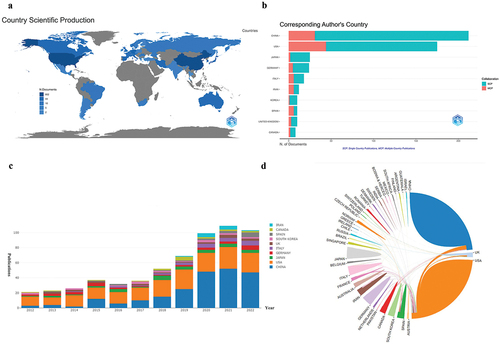
Analysis of historical cited paper in B7-H3/CI
Historiographic analysis was used to identify classic papers in this field (). The Local citation score (LCS) represents the number of citations of a paper in the downloaded dataset, whereas the global citation score (GCS) refers to the number of citations of an article cited by all papers in WoS. The LCS and GCS are indicators of the research quality of classic articles. The year 2017 (5) had the most publications in classical papers. The earliest paper, published in 2012, reported that higher expression of B7-H3 in hepatocellular carcinoma predicted poor clinicopathological characteristics and outcomes.Citation30 In 2013, Wang et al. demonstrated that B7-H3 accelerates the metastasis of osteosarcoma cells by upregulating matrix metalloproteinase-2.Citation31 In 2014, a retrospective study found that high B7-H3 expression caused metastatic nodes in primary urothelial carcinoma of the bladder.Citation32 In 2015 and 2017, two studies showed that B7-H3 is a prognostic factor for poor survival in lung cancer patients.Citation33,Citation34 Another study in 2017 showed that the downregulation of B7-H3 enhanced the function of cytotoxic lymphocytes to inhibit tumor growth.Citation35 In 2018, a paper published in Clinical Cancer Research indicated that B7-H3 could avoid immune surveillance and that an inhibitor of B7-H3 combined with ICIs was a promising therapy for patients expressing B7-H3.Citation36 In 2019, two studies found that B7-H3 could be an exciting target for treating chimeric antigen receptor T cell (CAR-T) pediatric and pancreatic cancer.Citation37,Citation38 Additional details are provided in .
Figure 6. History direct citation network in B7-H3/CI (each node corresponds to a paper, and the lines between the nodes represent the citation relationship).

Table 5. The papers of historical direct citation network related to B7-H3/CI.
Analysis of high-frequency keywords
In this study, 1324 author keywords and 1115 keywords plus were collected from the downloaded documents. Cloud maps of the hot words with the top 50 frequencies are shown in . After excluding search terms, the most common words for the author keywords were “immune checkpoint,” “PD-L1,” “prognosis,” “tumor microenvironment,” “PD-1,” etc. The most popular words for keywords plus were “expression,” “co-stimulatory molecule,” “activation,” “T-cell,” and “survival.”
Figure 7. (a) Word cloud of top 50 authors’ keywords in B7-H3/CI. (b) Word cloud of top 50 keywords plus in B7-H3/CI. (c) the cluster analysis of 122 keywords (frequency ≥10) in B7-H3/CI (the size of the node suggests the frequency of the keywords, and the thickness of the line between keywords indicates the total link strength). (d) trends in keywords (frequency ≥10) over time in B7-H3/CI.
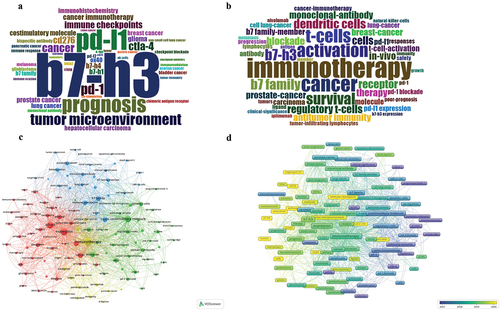
We conducted a co-occurrence analysis of all keywords and created a network visualization, as shown in . A total of 122 words with more than 10 co-occurrences were classified into four clusters. Cluster 1 (Red, 48 items) was the largest one, of which “immunotherapy” showed the maximum total link strength (1229), followed by “expression” (1001). In cluster 2 (Green, 31 items), the primary keyword was “co-stimulatory molecule” (689). For cluster 3 (blue, 26 items) and cluster 4 (yellow, 17 items), the domain keywords were “B7 family” (443) and “PD-L1” (469) respectively.
Analysis of keyword trends
As shown in , an overlay visualization was constructed to predict the future direction of B7-H3/CI. According to the year of appearance and frequency of publication, the VOS viewer matched different colors for 122 words. Over time, the boxes transitioned from blue to yellow, indicating the emergence of new keywords in recent years. This shift in color suggests that “chimeric antigen receptor” (2020.54), “pathways” (2020.47), and “targeting B7-H3” (2021.08) might be the latest areas of interest for research.
Discussion
Bibliometrics is a rapidly developing field with broad applications across various domains. It focuses on the literature as the research object and helps researchers quickly locate research hotspots and track research trends in their respective fields by extracting the quantitative features of the literature for visualization. Based on bibliometric analysis, this study detailed the current state of B7-H3/CI research, visually described the most influential countries, institutions, journals, and authors in the field, and predicted that “chimeric antigen receptors (CARs),” “pathways,” and “targeting B7-H3” may be a new research hotspot. From 2012 to 2022, the annual Np of B7-H3/CI steadily increased and has not yet reached its peak, which has enormous research potential in the future.
Our study showed that Frontiers in Immunology attracted the most manuscripts from this field and was a notable domain journal for publications on B7-H3/CI. China outstripped the USA in Np, but its TC was less than half that of the USA, indicating that American papers had higher quality and scholarly impact. First-class universities and academic institutions have played important roles in augmenting national academic influence. Six of the top 10 prolific institutions came from China, and these institutions were among the top universities located in the economically developed regions of China, which could explain why China has the largest NP. Regarding author analysis, Zang XX from Montefiore Med Ctr and Albert Einstein Coll Med published the most papers on B7-H3/CI and had the highest TC. Regarding the impact of articles, the most cited paper was authored by Topalian.
The top globally cited publications and historical citation networks reflect the general development of B7-H3/CI. Since 2012, several studies have shown that B7-H3 is highly expressed in multiple solid tumors, such as hepatocellular carcinoma, osteosarcoma, and non-small cell lung cancer, contributing to tumor progression and poor outcomes.Citation30,Citation31,Citation33 Exploration of the prognostic value of B7-H3 is one of the current research hotspots. In 2018, Kimio found that B7-H3 blockade increased the infiltration of CD8+ T cells and recovered their effector function, proving that a combination of anti-PD-1 and B7-H3 blockade was a promising treatment to improve immunotherapy efficiency in patients with high B7-H3-expressing.Citation36 This landmark finding fueled researchers’ enthusiasm for the clinical translation of B7-H3 blocking. However, the dual blockade of B7-H3 and PD-1 showed worse response rates in melanoma patients.Citation39
Trend analysis revealed that B7-H3 targeting could be a new research direction. CAR-T therapy uses CAR-modified T cells to recognize and attack cancer cells that express a specific antigen on their surface.Citation40 This study highlights the use of CAR-T cells targeting B7-H3, which has shown great promise in recent years compared to delivering CAR-T cells to atypical teratoid/rhabdoid and pediatric brain tumors.Citation41,Citation42 Seattle Children’s Hospital released preliminary first-in-human results (NCT04483778, STRIVE-02) on the use of CAR-T cells targeting B7-H3 in children and adolescents with relapsed or refractory solids. No dose-limiting toxicities were observed. After a single infusion, only three (33%) patients achieved stable disease, and the median survival time of CAR-T cells in the patients’ peripheral blood was 28 days. One patient received a second CAR-T infusion (1 × 106 CAR-T/kg), which resulted in a transient elevation of liver enzymes (grade 4), and the patient was assessed by PET/CT imaging as having a partial metabolic response 28 days after treatment.Citation43 Although CAR-T cells targeting B7-H3 have shown good efficacy and safety, constructing optimal B7-H3 CARs and exploring efficient routes of administration remains challenging.
Research on CAR-T cell therapy is currently the most extensive, and the early success of MGC018 and DS-7300a as B7-H3 blockade antibody – drug conjugates has accelerated the launch of clinical trials (NCT03729596, NCT05280470). A bispecific antibody (MDG009) targets CD3 and B7-H3 on T cells, and its safety and efficacy have been investigated in NCT03406949. B7-H3 blockade via antibody-dependent cellular cytotoxicity (NCT02982941, NCT02923180, and NCT02381314) and radioimmunotherapy (NCT04167618 and NCT04743661) are actively underway. Different types of antibodies and CAR-T cell therapies have reached the clinical trial stage (Supplementary Table S1), demonstrating the current focus on targeting B7-H3 in CI. However, the cost and toxicity of these therapies remain real concerns and may prevent their application in more sensitive populations.
B7-H3 is immunosuppressive molecule, involved in tumor immune escape as well as B7-H1. B7-H1 inhibits T cell activation by binding to the PD-1 receptor, helping tumor cells escape immune attack. B7-H3 inhibits the activity T cellCitation44 and NK cells,Citation19 and promote regulatory T cell responses.Citation45 These immunosuppressive effects will be modulated, and anti-tumor immune responses will be enhanced when blocking or targeting B7-H3. Additionally, B7-H3 is highly expressed in a variety of tumor cells, and this selective expression pattern also makes it a potential target for cancer-specific immunotherapy, reducing nonspecific effects on normal tissues. Although the success of PD-1/PD-L1 immunotherapy may not be directly extended to B7-H3, early clinical studies have demonstrated the effects of B7-H3 targeting. B7-H3 deserves attention as a potential target for immunotherapy, but further studies are needed to fully evaluate its efficacy, safety, and combination with other therapies.
At present, the receptor for B7-H3 has not been identified, which hinders the clinical application of B7-H3-based CI. Post-translational modifications refer to further chemical modifications of a protein after translation that can alter its function or stability.Citation46 However, few PTMs of B7-H3 have been reported in previous studies, thus presenting a new approach for targeting B7-H3. The expression of B7-H3 is heterogeneous, and its role in tumors and autoimmune diseases varies significantly. However, the exact reasons for these differences remain unclear. Variable splicing is a crucial mechanism for transcriptional regulation that could potentially shed light on this issue, but further research is required to corroborate this hypothesis. To better understand tumorigenesis and CI from a cellular biology perspective, investigation of B7-H3-mediated pathways of tumorigenic molecular mechanisms is a future research direction.
Our study had some limitations. Research on B7-H3 is a very new field, so the amount of relevant literature may be limited. However, this study on B7-H3 has great clinical translation significance, related researches have entered the clinical trial stage, and the number of related literatures is also rapidly accumulating. We only retrieved English publication data from the SCIE of the WoSCC because English is the main language used in the literature, and the WoSCC has vast and high-quality literature coverage. Moreover, the analysis software of bibliometrics has faced challenges in analyzing literature sourced from various databases and containing multiple languages. Additionally, IF and TC did not adequately represent the academic value of an article because papers from a research team specializing in the field may also be authoritative. Finally, we may neglect newly published articles that have a significant impact but fewer citations.
In conclusion, bibliometric analysis showed that research on B7-H3/CI is rapidly developing, and NP will continue to increase. China published the maximum number of NP in this domain, and the USA has considerable authority on this theme, owing to the highest impact of publications. CAR-T cell targeting of B7-H3” may be a new research trend in the future.
Supplemental Material
Download MS Word (19 KB)Supplemental Material
Download MS Word (40 KB)Disclosure statement
No potential conflict of interest was reported by the author(s).
Data availability statement
The raw data supporting the conclusions of this article will be made available by the authors without undue reservation.
Supplementary data
Supplemental data for this article can be accessed on the publisher’s website at https://doi.org/10.1080/21645515.2023.2246498.
Additional information
Funding
References
- Liu X, Cui Y, Zhang Y, Liu Z, Zhang Q, Wu W, Zheng Z, Li S, Zhang Z, Li Y. A comprehensive study of immunology repertoires in both preoperative stage and postoperative stage in patients with colorectal cancer. Mol Genet Genomic Med. 2019;7(3):e504. doi:10.1002/mgg3.504.
- Forde PM, Chaft JE, Smith KN, Anagnostou V, Cottrell TR, Hellmann MD, Zahurak M, Yang SC, Jones DR, Broderick S, et al. Neoadjuvant PD-1 blockade in resectable lung Cancer. N Engl J Med. 2018;378(21):1976–10. doi:10.1056/NEJMoa1716078.
- Lee JB, Kim HR, Ha S-J. Immune checkpoint inhibitors in 10 years: contribution of basic research and clinical application in Cancer immunotherapy. Immune Netw. 2022;22(1):e2. doi:10.4110/in.2022.22.e2.
- Falzone L, Salomone S, Libra M. Evolution of Cancer pharmacological treatments at the turn of the third millennium. Front Pharmacol. 2018;9:1300. doi:10.3389/fphar.2018.01300.
- Zhang Q, Luan J, Song L, Cong R, Ji C, Zhou X, Xia J, Song N. Age-related differences in molecular profiles for immune checkpoint blockade therapy. Front Immunol. 2021;12:657575. doi:10.3389/fimmu.2021.657575.
- Wu Z, Chen Q, Qu L, Li M, Wang L, Mir MC, Carbonara U, Pandolfo SD, Black PC, Paul AK, et al. Adverse events of immune checkpoint inhibitors therapy for urologic cancer patients in clinical trials: a collaborative systematic review and meta-analysis. Eur Urol. 2022;81(4):414–25. doi:10.1016/j.eururo.2022.01.028.
- Andrews LP, Yano H, Vignali DAA. Inhibitory receptors and ligands beyond PD-1, PD-L1 and CTLA-4: breakthroughs or backups. Nat Immunol. 2019;20(11):1425–34. doi:10.1038/s41590-019-0512-0.
- Sanmamed MF, Chen L. A paradigm shift in Cancer immunotherapy: from enhancement to normalization. Cell. 2018;175(2):313–26. doi:10.1016/j.cell.2018.09.035.
- Feng R, Chen Y, Liu Y, Zhou Q, Zhang W. The role of B7-H3 in tumors and its potential in clinical application. Int Immunopharmacol. 2021;101:108153. doi:10.1016/j.intimp.2021.108153.
- Hofmeyer KA, Ray A, Zang X. The contrasting role of B7-H3. Proc Natl Acad Sci USA. 2008;105(30):10277–8. doi:10.1073/pnas.0805458105.
- Chapoval AI, Ni J, Lau JS, Wilcox RA, Flies DB, Liu D, Dong H, Sica GL, Zhu G, Tamada K, et al. B7-H3: a costimulatory molecule for T cell activation and IFN-γ production. Nat Immunol. 2001;2(3):269–74. doi:10.1038/85339.
- Li G, Quan Y, Che F, Wang L. B7-H3 in tumors: friend or foe for tumor immunity? Cancer Chemother Pharmacol. 2018;81(2):245–53. doi:10.1007/s00280-017-3508-1.
- Zou W, Chen L. Inhibitory B7-family molecules in the tumour microenvironment. Nat Rev Immunol. 2008;8(6):467–77. doi:10.1038/nri2326.
- Huang Y, Zhang H-L, Li Z-L, Du T, Chen Y-H, Wang Y, Ni H-H, Zhang K-M, Mai J, Hu B-X, et al. FUT8-mediated aberrant N-glycosylation of B7H3 suppresses the immune response in triple-negative breast cancer. Nat Commun. 2021;12(1):2672. doi:10.1038/s41467-021-22618-x.
- Zhou Y-H, Chen Y-J, Ma Z-Y, Xu L, Wang Q, Zhang G-B, Xie F, Ge Y, Wang X-F, Zhang X-G. 4IgB7-H3 is the major isoform expressed on immunocytes as well as malignant cells. Tissue Antigens. 2007;70(2):96–104. doi:10.1111/j.1399-0039.2007.00853.x.
- Zhang G, Hou J, Shi J, Yu G, Lu B, Zhang X. Soluble CD276 (B7-H3) is released from monocytes, dendritic cells and activated T cells and is detectable in normal human serum. Immunology. 2008;123(4):538–46. doi:10.1111/j.1365-2567.2007.02723.x.
- Chen W, Liu P, Wang Y, Nie W, Li Z, Xu W, Li F, Zhou Z, Zhao M, Liu H, et al. Characterization of a Soluble B7-H3 (sB7-H3) spliced from the intron and analysis of sB7-H3 in the Sera of patients with hepatocellular carcinoma. PLoS One. 2013;8(10):e76965. doi:10.1371/journal.pone.0076965.
- Prasad DVR, Nguyen T, Li Z, Yang Y, Duong J, Wang Y, Dong C. Murine B7-H3 is a negative regulator of T cells. J Immunol. 2004;173(4):2500–6. doi:10.4049/jimmunol.173.4.2500.
- Cai D, Li J, Liu D, Hong S, Qiao Q, Sun Q, Li P, Lyu N, Sun T, Xie S, et al. Tumor-expressed B7-H3 mediates the inhibition of antitumor T-cell functions in ovarian cancer insensitive to PD-1 blockade therapy. Cell Mol Immunol. 2020;17(3):227–36. doi:10.1038/s41423-019-0305-2.
- Zhao X, Zhang G-B, Gan W-J, Xiong F, Li Z, Zhao H, Zhu D-M, Zhang B, Zhang X-G, Li D-C. Silencing of B7-H3 increases gemcitabine sensitivity by promoting apoptosis in pancreatic carcinoma. Oncol Lett. 2013;5(3):805–12. doi:10.3892/ol.2013.1118.
- Nunes-Xavier CE, Karlsen KF, Tekle C, Pedersen C, Øyjord T, Hongisto V, Nesland JM, Tan M, Sahlberg KK, Fodstad Ø. Decreased expression of B7-H3 reduces the glycolytic capacity and sensitizes breast cancer cells to AKT/mTOR inhibitors. Oncotarget. 2016;7(6):6891–901. doi:10.18632/oncotarget.6902.
- Picarda E, Ohaegbulam KC, Zang X. Molecular pathways: targeting B7-H3 (CD276) for human Cancer immunotherapy. Clin Cancer Res. 2016;22(14):3425–31. doi:10.1158/1078-0432.CCR-15-2428.
- Cheng N, Bei Y, Song Y, Zhang W, Xu L, Zhang W, Yang N, Bai X, Shu Y, Shen P. B7-H3 augments the pro-angiogenic function of tumor-associated macrophages and acts as a novel adjuvant target for triple-negative breast cancer therapy. Biochem Pharmacol. 2021;183:114298. doi:10.1016/j.bcp.2020.114298.
- Zhou W-T, Jin W-L. B7-H3/CD276: An emerging Cancer immunotherapy. Front Immunol [Internet]. 2021;12. [accessed 2023 Jan 12]. https://www.frontiersin.org/articles/10.3389/fimmu.2021.701006/full.
- Li Z-Y, Wang J-T, Chen G, Shan Z-G, Wang T-T, Shen Y, Chen J, Yan Z-B, Peng L-S, Mao F-Y, et al. Expression, regulation and clinical significance of B7-H3 on neutrophils in human gastric cancer. Clin Immunol. 2021;227:108753. doi:10.1016/j.clim.2021.108753.
- Zhang W, Acuna-Villaorduna A, Kuan K, Gupta S, Hu S, Ohaegbulam K, Albanese J, Kaumaya M, Levy R, Hwang RR, et al. B7-H3 and PD-L1 expression are prognostic biomarkers in a multi-racial cohort of patients with colorectal Cancer. Clin Colorectal Cancer. 2021;20(2):161–9. doi:10.1016/j.clcc.2021.02.002.
- Zhao B, Li H, Xia Y, Wang Y, Wang Y, Shi Y, Xing H, Qu T, Wang Y, Ma W. Immune checkpoint of B7-H3 in Cancer: from immunology to clinical immunotherapy. J Hematol Oncol. 2020;15(1):153. doi:10.1186/s13045-022-01364-7.
- Chen C, Song M, Glanzel W. Visualizing a field of research: a methodology of systematic scientometric reviews. PLoS One. 2019;14(10):e0223994. doi:10.1371/journal.pone.0223994.
- Roldan-Valadez E, Salazar-Ruiz SY, Ibarra-Contreras R, Rios C. Current concepts on bibliometrics: a brief review about impact factor, eigenfactor score, CiteScore, SCImago journal Rank, source-normalised impact per paper, H-index, and alternative metrics. Ir J Med Sci. 2019;188:939–51. doi:10.1007/s11845-018-1936-5.
- Sun T-W, Gao Q, Qiu S-J, Zhou J, Wang X-Y, Yi Y, Shi J-Y, Xu Y-F, Shi Y-H, Song K, et al. B7-H3 is expressed in human hepatocellular carcinoma and is associated with tumor aggressiveness and postoperative recurrence. Cancer Immunol Immunother. 2012;61(11):2171–82. doi:10.1007/s00262-012-1278-5.
- Wang L, Zhang Q, Chen W, Shan B, Ding Y, Zhang G, Cao N, Liu L, Zhang Y, Marie PJ. B7-H3 is overexpressed in patients suffering osteosarcoma and associated with tumor aggressiveness and metastasis. PLoS One. 2013;8(8):e70689. doi:10.1371/journal.pone.0070689.
- Xylinas E, Robinson BD, Kluth LA, Volkmer BG, Hautmann R, Küfer R, Zerbib M, Kwon E, Thompson RH, Boorjian SA, et al. Association of T-cell co-regulatory protein expression with clinical outcomes following radical cystectomy for urothelial carcinoma of the bladder. Euro J Surg Oncol (EJSO). 2014;40(1):121–7. doi:10.1016/j.ejso.2013.08.023.
- Mao Y, Li W, Chen K, Xie Y, Liu Q, Yao M, Duan W, Zhou X, Liang R, Tao M. B7-H1 and B7-H3 are independent predictors of poor prognosis in patients with non-small cell lung cancer. Oncotarget. 2015;6(5):3452–61. doi:10.18632/oncotarget.3097.
- Inamura K, Yokouchi Y, Kobayashi M, Sakakibara R, Ninomiya H, Subat S, Nagano H, Nomura K, Okumura S, Shibutani T, et al. Tumor B7-H3 (CD276) expression and smoking history in relation to lung adenocarcinoma prognosis. Lung Cancer. 2017;103:44–51. doi:10.1016/j.lungcan.2016.11.013.
- Lee Y, Martin-Orozco N, Zheng P, Li J, Zhang P, Tan H, Park HJ, Jeong M, Chang SH, Kim B-S, et al. Inhibition of the B7-H3 immune checkpoint limits tumor growth by enhancing cytotoxic lymphocyte function. Cell Res. 2017;27(8):1034–45. doi:10.1038/cr.2017.90.
- Yonesaka K, Haratani K, Takamura S, Sakai H, Kato R, Takegawa N, Takahama T, Tanaka K, Hayashi H, Takeda M, et al. B7-H3 negatively modulates CTL-Mediated Cancer immunity. Clin Cancer Res. 2018;24(11):2653–64. doi:10.1158/1078-0432.CCR-17-2852.
- Majzner RG, Theruvath JL, Nellan A, Heitzeneder S, Cui Y, Mount CW, Rietberg SP, Linde MH, Xu P, Rota C, et al. CAR T cells targeting B7-H3, a pan-cancer antigen, demonstrate potent preclinical activity against pediatric solid tumors and brain tumors. Clin Cancer Res. 2019;25(8):2560–74. doi:10.1158/1078-0432.CCR-18-0432.
- Du H, Hirabayashi K, Ahn S, Kren NP, Montgomery SA, Wang X, Tiruthani K, Mirlekar B, Michaud D, Greene K, et al. Antitumor responses in the absence of toxicity in solid tumors by targeting B7-H3 via chimeric antigen receptor T cells. Cancer Cell. 2019;35(2):221–37.e8. doi:10.1016/j.ccell.2019.01.002.
- Aggarwal C, Prawira A, Antonia S, Rahma O, Tolcher A, Cohen RB, Lou Y, Hauke R, Vogelzang NP, Zandberg D, et al. Dual checkpoint targeting of B7-H3 and PD-1 with enoblituzumab and pembrolizumab in advanced solid tumors: interim results from a multicenter phase I/II trial. J Immunother Cancer. 2022;10(4):e004424. doi:10.1136/jitc-2021-004424.
- Depil S, Duchateau P, Grupp SA, Mufti G, Poirot L. ‘Off-the-shelf’ allogeneic CAR T cells: development and challenges. Nat Rev Drug Discov. 2020;19(3):185–99. doi:10.1038/s41573-019-0051-2.
- Theruvath J, Sotillo E, Mount CW, Graef CM, Delaidelli A, Heitzeneder S, Labanieh L, Dhingra S, Leruste A, Majzner RG, et al. Locoregionally administered B7-H3-targeted CAR T cells for treatment of atypical teratoid/rhabdoid tumors. Nat Med. 2020;26(5):712–9. doi:10.1038/s41591-020-0821-8.
- Haydar D, Houke H, Chiang J, Yi Z, Odé Z, Caldwell K, Zhu X, Mercer KS, Stripay JL, Shaw TI, et al. Cell-surface antigen profiling of pediatric brain tumors: B7-H3 is consistently expressed and can be targeted via local or systemic CAR T-cell delivery. Neuro Oncol. 2021;23(6):999–1011. doi:10.1093/neuonc/noaa278.
- Pinto NR, Albert CM, Taylor M, Wilson A, Rawlings-Rhea S, Huang W, Seidel K, Narayanaswany P, Wu V, Brown C. STRIVE-02: a first-in-human phase 1 trial of systemic B7H3 CAR T cells for children and young adults with relapsed/refractory solid tumors. J Clin Oncol. 2022;40(16_suppl):10011–10011. doi:10.1200/JCO.2022.40.16_suppl.10011.
- Wang C, Li Y, Jia L, Kim JK, Li J, Deng P, Zhang W, Krebsbach PH, Wang C-Y. CD276 expression enables squamous cell carcinoma stem cells to evade immune surveillance. Cell Stem Cell. 2021;28(9):1597–1613.e7. doi:10.1016/j.stem.2021.04.011.
- Jin Y, Zhang P, Li J, Zhao J, Liu C, Yang F, Yang D, Gao A, Lin W, Ma X, et al. B7-H3 in combination with regulatory T cell is associated with tumor progression in primary human non-small cell lung cancer. Int J Clin Exp Pathol. 2015;8(11):13987–95.
- Crine SL, Acharya KR. Molecular basis of C‐mannosylation – a structural perspective. FEBS J. 2022;289(24):7670–87. doi:10.1111/febs.16265.

